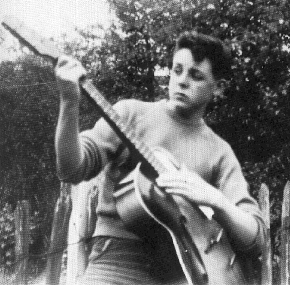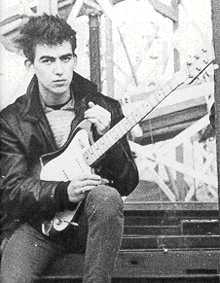| |
The Beatles and their guitars (and drums!)
The Instruments which created a Dream.
Part One - 1956-1959
| __________________________________________________________ |
| |
1 - "Home Made":
George's first guitar was made by himself, according to Paul.
We were talking on the bus and we had the same interest in music and guitars. He was trying to build a guitar, small, solid body, like those "small Hawaiian ukeleles". He managed to do it and we became good friends. It was not bad, it was a good start.
There are no pictures of this first guitar, neither information about its destiny. |
| __________________________________________________________ |
|
2 - Egmond Toledo:
Finishing: sunburst
Model: 105/0
Start of Use: 1956
End of Use: March, 1958
Destiny: In the UK, the instruments made by Egmond (from Holland), were distributed by Rosetti. Thus, George's guitar had a brand name of Rosetti 276. Its body was made of Birch plywood. This guitar was auctioned in London, during the 1980's. Since 1995 it was on the Cleveland's "Rock and Roll Hall of Fame", donated by its anonymous owner. In 2003 its was auctioned again and reached a sale price of £ 276.000!
George bought this "guitar for beginners" of a school friend, using the 3 pounds he had gained from his mother. When trying to adjust it, he unscrewed the neck. After a few weeks on top of the closet, his brother Pete managed to fix the guitar, allowing George made his debut in 1957 at the British Legion Club in Speke.
There, The Rebels, a skiffle group formed by the Harrisons and three friends, played for the first (and last!) time.
|
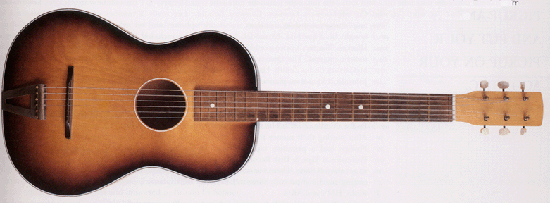 |
| __________________________________________________________ |

Paul at his office,where he took photos with theguitar and wrote a letter of endorsement to the auction.
|
2b - Rex:
Finishing: sunburst
Model: "acoustic"
Start of Use: 1955
End of Use: June, 1956
Details: Acoustic guitar manufactured in east Europe, with "f" holes. There's no information about its body (probably made with plywood), neither its nut (probably made in rosewood).
Destiny: This guitar, owned by schoolmate from Paul, was auctioned in July, 2013, for £ 330.000.
In 1955, Paul still didn't have a guitar. A schoolmate, Ian James, had a Rex guitar.
In this guitar he learned teh first chords which has led him to impress John Lennon some time ago.
One year on Paul finally won his first instrument.
|
 |
| __________________________________________________________ |
|
3 - Framus Zenith:
Finishing: sunburst
Model: 17
Start of Use: June, 1956
End of Use: May, 1960
Details: Acoustic guitar manufactured in Germany, with "f" holes and a white pickguard. Body made with plywood, fretboard and nut in rosewood.
Destiny: Paul bought this guitar for £ 14,70 (£ 215 in current values), and it's at his famous Replica studio, at the MPL office, in London's Soho.
Paul won a trumpet from his father as a birthday gift. Soon he returned in the same shop, swapping the trumpet for this beautiful guitar. But he couldn't play anything.
I hadn't realized that because I'm left-handed, I couldn't play right. Seeing a picture of Slim Whitman, who was also a left-handed, I discovered that I had to reverse the position of the instrument.
This guitar could be heard on the recording of That'll Be The Day / In Spite Of All The Danger, held in 1958, with Paul, John, George, John "Duff" Lowe (piano) and Colin Hanton (drums).
|
 |
| __________________________________________________________ |
 |
4 - Gallotone Champion:
Finishing: sunburst
Start of Use: March, 1957
End of Use: August, 1959
Details: A very cheap south-african guitar, made of plywood.
Destiny: It was auctioned at Sotheby's, in London, for USD 250.000, in 1999.
John bought this guitar for £ 6 (£ 90 in current values), thru a newspaper add, and formed his first band, the Black Jacks, together with his friend Pete Shotton.
With new friends as members, the band was renamed to the Quarry Men.
It was with this instrument that, in July 6th, 1957, on a Garden Fete at the St. Peter's Church, in Woolton, the young Paul McCartney saw John and his group.
This guitar could be heard on the recording of That'll Be The Day / In Spite Of All The Danger, held in 1958, with John, Paul, George, John "Duff" Lowe and Colin Hanton.
John's original guitar at the auction.
|
 |
| __________________________________________________________ |
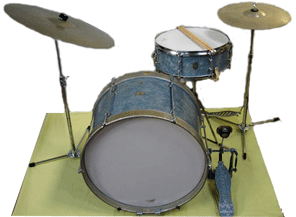
On the picture above, the floor tom is missing. But possibly this is the same model used by Ringo

|
5 - Ajax drums:
Finishing: probably "Blue Oyster"
Model: unknown
Start of Use: May, 1957
End of Use: July, 1960
Destiny: unknown
Original logo: None
Drumheads: Unknown
Bass drum: 20"x14"
Floor tom: 14"x14"
Toms: 1 of 12"x8"
Snare drum : 14"x5"
Crash: Ajax 16"
Hi-Hat: Ajax 13"
With 18 years-old, Ringo had his first "serious drums ". It was a gift from his stepfather.
He started to play with the Eddie Clayton Skiffle Group. Ringo played with them until 1959, when got into the Darktown Skiffle, where played for few weeks.
The photo at left is one of the few known photos of Ringo with Eddie's group.
Ritchie Starkey - drums
Frank Walsh - guitar
Roy Trafford - tea-chest bass
John Dougherty - washboard
Eddie Miles ("Eddie Clayton") - guitar/vocals
|
| __________________________________________________________ |
|
6 - Hofner President:
Finishing: sunburst
Start of Use: March, 1958
End of Use: August, 1959
Details: Acoustic "archtop" style guitar with "f" holes. Top in carved spruce and back and sides in flamed maple. Came with black pickguard and bridge model "compensator".
Destiny: It was swapped by another guitar, this time an electric, with one of the Swinging Blue Jeans members.
On a considerable improvement, George bought for £ 30 (£ 475 in current values), once again with a little help from his mother, eternal supporter of his talent, this beautiful acoustic guitar, Hofner's top-of-line.
Later George installed a small pickup, getting more volume.
This guitar could be heard on the recording of That'll Be The Day / In Spite Of All The Danger, held in 1958, with George, John, Paul, John "Duff" Lowe and Colin Hanton. |
 |
| __________________________________________________________ |

On the picture above, the floor tom is missing. But possibly this is the same model used by Ringo
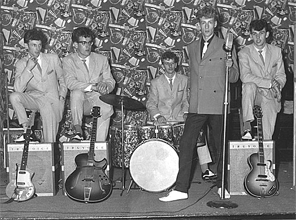
|
7 - Ajax drums:
Finishing: probably "Blue Oyster"
Model: unknown
Start of Use: May, 1957
End of Use: July, 1960
Destiny: unknown
Original logo: None
Drumheads: Unknown
Bass drum: 20"x14"
Floor tom: 14"x14"
Toms: 1 of 12"x8"
Snare drum : 14"x5"
Crash: Ajax 16"
Hi-Hat: Ajax 13"
After few shows with the Darktown Skiffle, Ringo started playing with Rory Storm and the Hurricanes. This group became successful long before the Beatles and soon became an opponent to be beaten in terms of popularity.
The Beatles always watch the drummer of Rory, Richard "Ritchie" Starkey, who adopted the stage name Ringo (derivative of Rings), as he wore several rings.
Johnny Byrne "Johnny Guitar" (rhythm guitar)
Wally Eymond "Lu Walters" (bass/vocals)
Ritchie Starkey "Ringo" (drums)
Alan Caldwell "Rory Storm" (vocals)
Charles O'Brien "Ty O'Brien" (lead guitar) |
| __________________________________________________________ |
|
8 - Hofner Club 40:
Finishing: light varnished wood (blonde)
Model: 126/B
Pickups: one Club 40
Start of Use: August, 1959
End of Use: November, 1959
Details: Semi-hollow electric guitar (although it looks like an solid guitar), no holes, with top in spruce, fretboard in rosewood.
Destiny: According to George, this guitar was swapped for something that he don't remember anymore.
Guitar made in Germany, was distributed in the UK by Selmer. It was acquired in a trade with Ray Ennis, guitarist of the group Swinging Blue Jeans, where George gave his Hofner President. Ennis can't remember where is this guitar.
George used this new Hofner at shows throughout Liverpool. Soon he would be disappointed with this guitar because one of his idols, Buddy Holly, had a Fender Stratocaster.
|
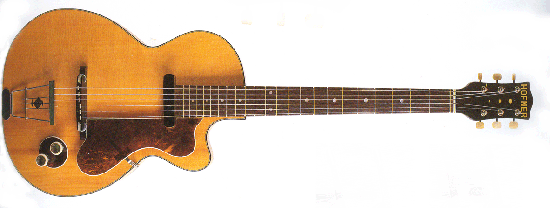 |
| __________________________________________________________ |
|
9 - Hofner Club 40:
Finishing: light varnished wood (blonde)
Model: 126/B
Pickups: one Club 40
Start of Use: August, 1959
End of Use: August, 1960
Details: Semi-hollow electric guitar (although it looks like an solid guitar), no holes, with top in sprouce, fretboard in rosewood.
Destiny: It was sold in Hamburg to help John to buying his future Rickenbacker.
John's aunt, Mimi, made a leasing of £ 30.45 (£ 400 at current values) at Hessy's Music store and bought this guitar for his nephew. The first presentation where John played with the new guitar was the inauguration of the Casbah Coffee Club, owned by Mrs. Mona Best, mother of the future Beatles drummer, Pete.
He stayed with this guitar until the following year, when it would be loaned to Paul, whom can't decide which instrument to play. Then it was sold in Hamburg, where John would buy the instrument that would be synonymous of Beatles.
The main differences of this guitar regarding to George's are the rectangular shape of its control panel and the Hofner logo in vertical position.
The only recordings where John's Club 40 can be heard are on a bootleg with rehearsals done by the Beatles in June-July 1960, at Paul's home.

|
 |
| __________________________________________________________ |
| |
10 - Dallas:
Finishing: tobacco sunburst
Model: Tuxedo
Pickups: two solid made by Henri Weil
Start of Use: November, 1959
End of Use: November, 1959
Details: British solid-body guitar, made of mahogany, very limited in terms of sound and resources.
Destiny: was stored at Mendips' attic (Aunt Mimi's house), until the new owner gave it to be exhibited at the Beatles Story until July, 2012, when it was auctioned by Bonhams.
During the last or penultimate presentation of Johnny and the Moondogs in Lewis Carroll's contest in Manchester, John was without a guitar. Seeing this Dallas literally "up for grabs", he took the instrument, used it and ran with it back to Liverpool.
Reports show that he was seen with the guitar in the kitchen of his house, and when the new owners were at Mendips' attic many years later, the guitar was there, along with two banjos and magazines.
As far as we know, John never played with this guitar on any show.
|
 |
| __________________________________________________________ |
|
6 - Neoton Futurama Grazioso Resonet:
Finishing: sunburst
Pickups: três captadores, semelhantes aos da Fender
Vibrato: sim
Start of Use: Novembro de 1959
End of Use: Agosto de 1961
Details: Solid body electric guitar (maple or beech), similar to the Fender Stratocaster. Based on Fender design, all electrical and tremolo parts were redesigned, greatly improving the Americans' project. The three pickups had individual "piano" type toggle switches which allowed seven combinations of pickup selections (it was more advanced than the Fender, which only had three combinations in those days!), the pickups had invividual adjustable polos and and the tone control was for the three pickups (the Stratocaster only worked for the bridge pickup and arm). The tremolo system far exceeded the Fender as it had individual bridge saddle adjustment and six individual springs acting on each string, being the source of inspiration for future models, as the Floyd Rose. The big problem with this guitar was that the action of the strings was very high, almost 1.5 cm above the scale..
Destiny: In 1964, George gave this guitar as a prize on a raffle among readers of the "Beat Instrumental" magazine, whose editor was Sean O'Mahony (who would found the "Beatles Book"). The winner was AJ Thompson that by not playing guitar, he accepted money in exchange. O'Mahony still has the guitar today.
George went to the Hessy's Music store in Liverpool, looking for a new guitar, since he wanted to buy a "Stratocaster". But no american gear was sold in the UK in those days due a trade embargo. What Frank Hessy brought this guitar was manufactured originally by Neoton in the former Czechoslovakia, under the name Grazioso Resonet. It was renamed to Selmer Futurama by the importer who brought these instruments to England, where it was sold for £ 57.75 (a fortune in those days - again George's mother gave a "helping hand" by signing the lease paperwork to be able to buy it). In current values it would be £ 780.
George remembers that Paul went with him to the store. He plugged the guitar into the amp, but no sound came out. He increased the volume, while turned on one of the pickups (which were connected individually by means of switches) and then a "boom" came from the speaker, causing the fall of all other guitars from the wall of the store.
During the second visit to Hamburg, George used his Futurama on the recordings for the German Polydor label, produced by Bert Kaempfert, where the Beatles were backing the English singer Tony Sheridan (June, 1961). The sound of this guitar could be well heard on his instrumental composition (with John), Cry For A Shadow.
Returning to Liverpool, George will buy a new guitar, because his style had improved and this guitar was very difficult to play because of the height of your strings, despite having an excellent tone. |
 |
| __________________________________________________________ |
Visit the other pages...
The pages are updated regularly and new instruments or photos are added!
Home 1960 1961-1962 1963 1964 1965 1966 1967 1968 1969 1970
|





